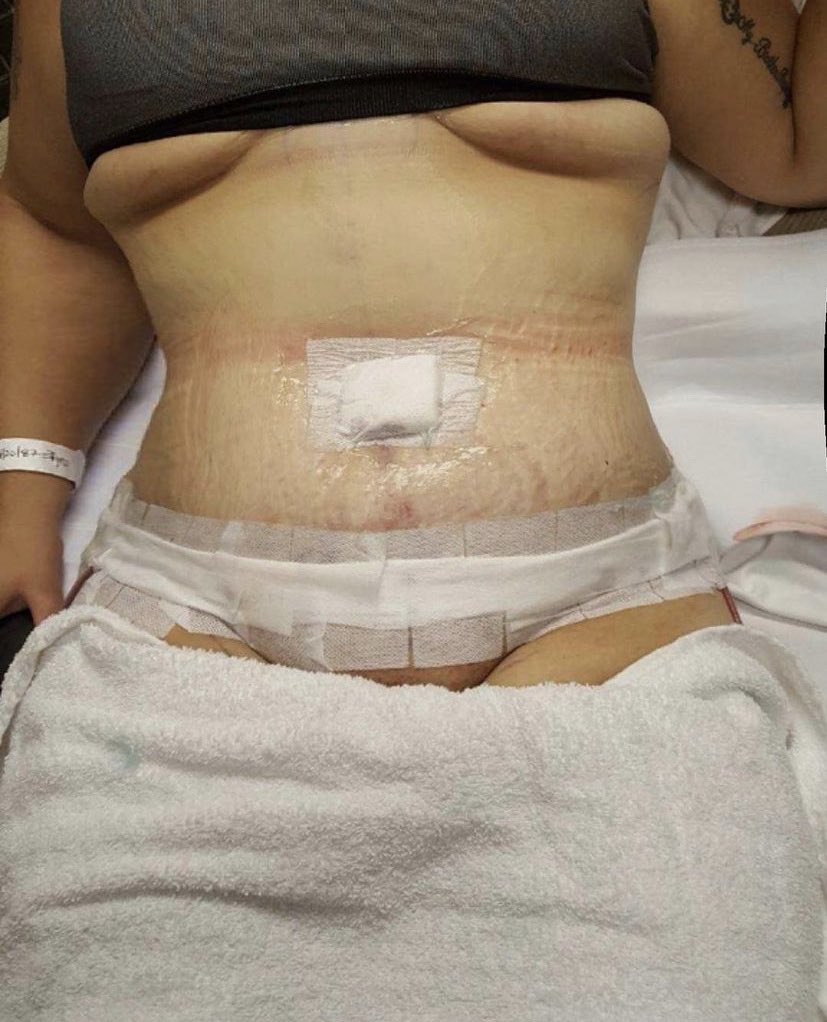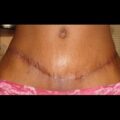A tummy tuck is a cosmetic surgical procedure to improve the appearance of the abdomen. During a tummy tuck — also known as abdominoplasty — excess skin and fat are removed from the abdomen. Connective tissue in the abdomen (fascia) usually is tightened with sutures as well. The remaining skin is then repositioned to create a more toned look.
Tummy tuck is the sixth most common cosmetic surgical procedure performed in the United States, with more than 117,000 procedures performed in 2014, according to ASPS statistics. The number of abdominoplasties has increased in recent years—partly because of the increased number of patients undergoing body contouring surgery to remove excess skin and tissue after massive weight loss.
How is tummy tuck done?
Depending on the results you want, this surgery can take anywhere from one to five hours. Surgery is generally done as an outpatient procedure. If you are traveling out of town to a facility to have the procedure done, you’ll be asked to stay overnight at a hotel. Liposuction may or may not be recommended at the same time.
You will receive general anesthesia, which will put you to sleep during the operation. It’s important to have someone with you who can drive you home. If you live alone and you’re sent home after the procedure, you also will need someone to stay with you at least the first night after the surgery.
Complete abdominoplasty: This option is for patients who need the most correction. The incision (cut) is made at the bikini line, at about the same level as your pubic hair. The length of the scar depends on the amount of extra skin. Your surgeon will then manipulate and shape the skin and muscle as needed. You will also have an incision around your navel (belly button) with this procedure, because it’s necessary to free your navel from surrounding tissue. Drainage tubes may or may not be placed under your skin. These will be removed in a few days as your surgeon sees fit.
Partial or mini-abdominoplasty: Mini-abdominoplasties are done with shorter incisions and are often performed on people who have less excess skin. Your belly button most likely won’t be moved during this type of procedure. Your skin will be separated between the line of incision and your belly button. This procedure generally takes one to two hours. As with the complete abdominoplasty, you may or may not have drainage tubes after surgery.
Circumferential abdominoplasty: This surgery includes the back area. When there is a lot of excess fat in the back as well as the abdomen, you may have either liposuction of the back or circumferential abdominoplasty. The latter procedure allows for the removal of both skin and fat from the hip and back areas, which improves the shape of your body from all sides.
After your partial or complete tummy tuck, your incision site will be stitched and bandaged. Your surgeon may have you wear an elastic bandage or compression garment after surgery. If so, it’s very important that you follow all of your surgeon’s instructions on wearing this garment and caring for the bandage. Your surgeon will also tell you about the best way to sit or lie down so you’ll be in the least amount of pain.
If you’re exceptionally physically active, you’ll have to severely limit strenuous exercise for four to six weeks. Your doctor will advise you on this as you go through the healing process. Generally, one week off work after the surgery is sufficient for most people to recover properly. Again, your doctor will help you determine this.
Tummy tuck and stitches
While performing a tummy tuck, three types of sutures are used. There are permanent sutures, which as the name implies, are permanent. These sutures should last you a lifetime. The sutures are used to tighten or plicate the six-pack or rectus abdominis muscles. These permanent sutures lead to a flat belly for years to come. The rest of the sutures are absorbable. Three sutures are commonly used during a tummy tuck. PDS sutures are often used. PDS sutures usually dissolve at 238 days. Vicryl sutures are also often used. Vicryl sutures dissolve by 70 days. Monocryl sutures are also used. Monocryl sutures dissolve at 119 days.
Are the tummy tuck sutures absorbable?
98% of the sutures used during a tummy tuck are absorbable. Absorbable sutures are used to re-approximate the skin layers. Permanent sutures are used to re-approximate two different fascial layers. Fascia is a layer of tough connective tissue that often separates anatomic structures and surrounds muscles.
Permanent sutures are often used to re-approximate Scarpa’s fascia. Also, permanent sutures are used to flatten the abdominal wall muscles by tightening the rectus abdominis muscles. This row of rectus abdominis sutures corrects for rectus muscle laxity and rectus diastasis (gapping in the rectus muscle). Rectus muscle laxity and rectus diastasis often occur with pregnancy and/or weight gain and subsequent weight loss. Usually, doctors place two or more layers of these permanent sutures on the rectus abdominis muscle. These permanent sutures are placed from the xiphoid (bottom of the sternum) to the top of the pubic region. These rectus muscle sutures are permanent and do not need to be removed.
After a tummy tuck, do any sutures need to be removed?
Sometimes areas of skin discrepancy need one or two sutures. One or two weeks after the tummy tuck, these sutures are removed. The removal of these tiny sutures is usually painless. Sutures also need to be withdrawn from the drain site. Usually, there are one or two sutures that are used to anchor the drain to the skin. When the drains are removed, the drain sutures are also removed.
What are the symptoms of torn internal stitches after tummy tuck?
Just like with any surgery, complications can occur after tummy tuck, your body needs time to heal afterward. Expect to stay in the hospital for few days or longer if there are complications, and give your body up to six weeks to fully heal. The following are some symptoms of torn internal stitches and signs of complication after tummy tuck:
- Severe pain in the incision
- Fever
- Incision looks infected (spreading redness, pain) and large red area
- Incision looks infected (spreading redness, pain) and on face
- Red streak runs from the incision
- Stitch (or staple) came out early and wound has re-opened
- You feel weak or very sick
Occasionally, a stitch won’t dissolve completely. This usually occurs when part of the stitch is left on the outside of the body. There, the body’s fluids cannot dissolve and decompose the stitch, so it remains intact. A doctor can easily remove the remaining piece of stitch once the wound is closed.
How common are complications after tummy tuck?
Complication risk is particularly high for the large proportion of patients undergoing abdominoplasty in combination with other procedures, according to an analysis of nationwide data. Studies indicate that combined procedures can significantly increase complication rates and should be considered carefully in higher-risk patients.
When researchers analyzed tummy tuck complication rates and risk factors using the nationwide CosmetAssure database, an insurance program providing coverage for complications related to cosmetic plastic surgery procedures, which are typically not covered by health insurance, they discovered that major complications occurred in four percent of patients undergoing tummy tuck—significantly higher than the 1.4 percent rate after other cosmetic surgery procedures. Hematomas (blood collections) were the most common major complication, followed by infections, blood clots (venous thromboembolism), and lung-related problems.
Combined procedures were a key risk factor for complications. Compared to the 3.1 percent rate with tummy tuck alone, risk increased when tummy tuck was combined with other procedures: up to 10.4 percent when tummy tuck was combined with body contouring plus liposuction. After adjustment for other factors, the relative risk of major complications was 50 percent higher with combined procedures.
Other risk factors for major complications included male sex, age 55 years or older, and obesity. Risk was lower when tummy tuck was performed in an office-based surgical suite, compared to a hospital or surgical center.
Diabetes and smoking—two major surgical risk factors—were not associated with a significant increase in complications after tummy tuck. That likely reflected Board-certified plastic surgeons’ practice of not offering tummy tuck to poorly controlled diabetics and recommending strict smoking cessation for at least four weeks before and after surgery.






